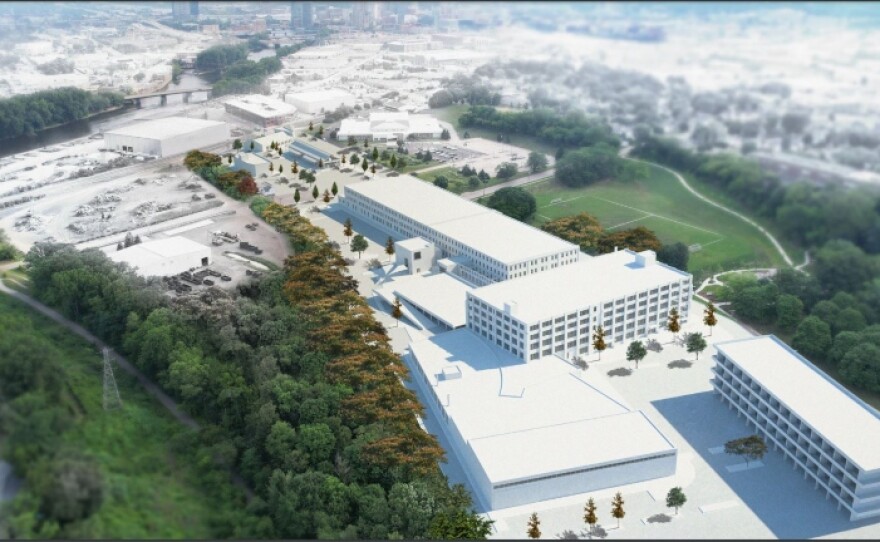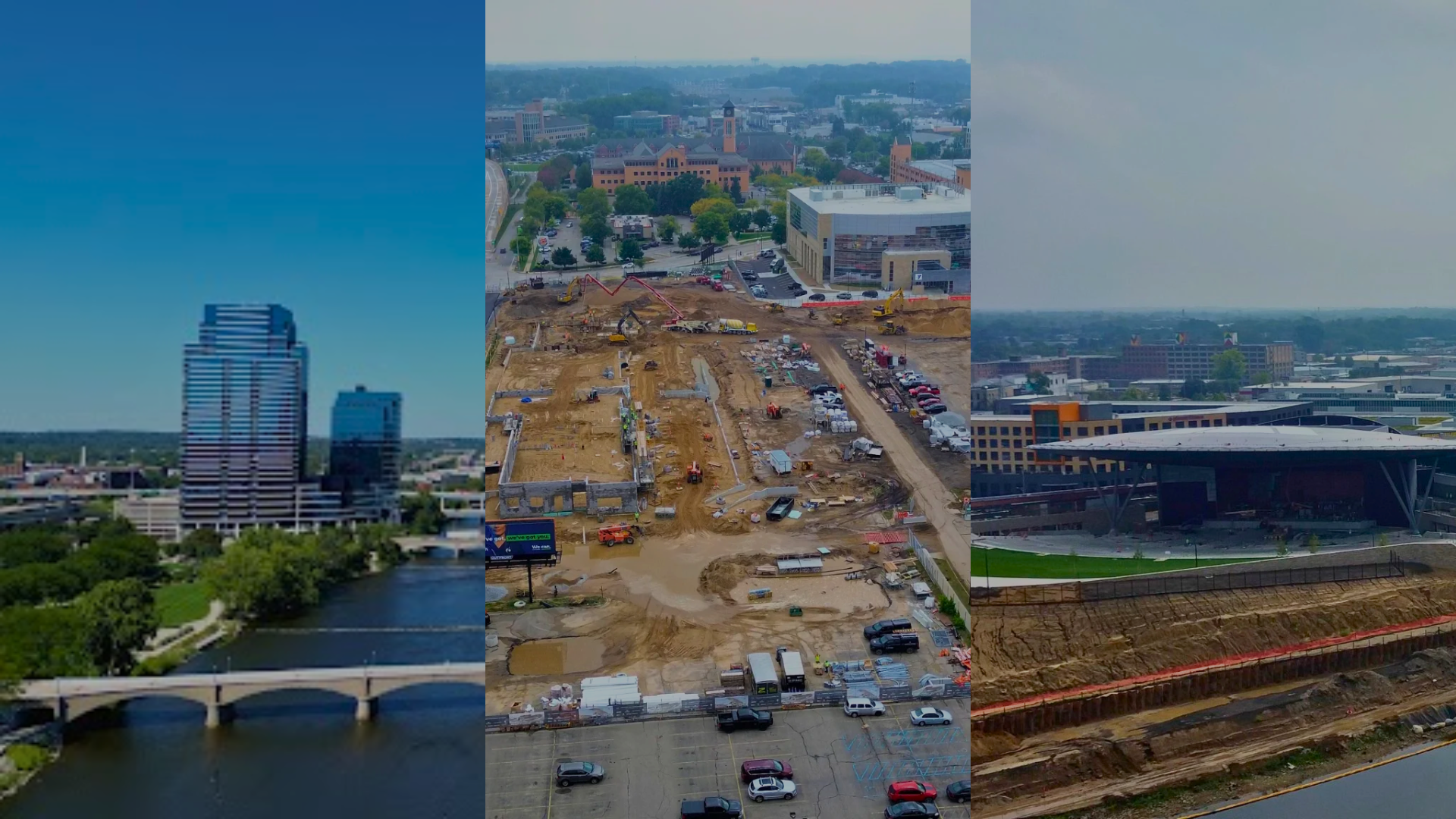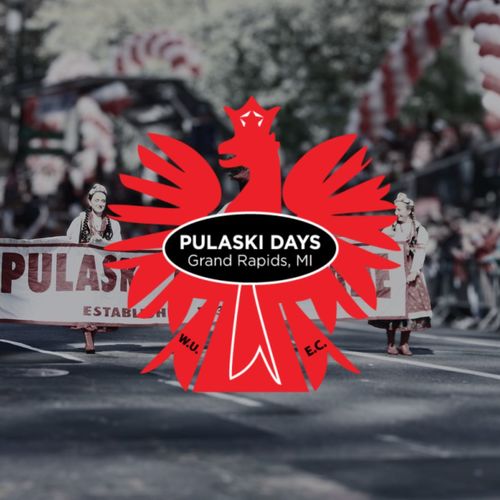There’s a lot happening across Grand Rapids right now.
From the riverfront to the west side, cranes and concrete are shaping what’s next for the city. These aren’t small updates. They’re the kind of projects that change how people live, move, and gather downtown. If you live here, work here, or you’re watching where the city is headed, these developments are worth knowing about.
Acrisure Amphitheater
On Market Avenue along the river, crews are building the new 12,000-seat Acrisure Amphitheater. It broke ground in May 2024 and is expected to open by spring 2026.
The amphitheater is part of a $184 million plan to completely remake the riverfront into a walkable district with trails, housing, public space, and local businesses. Once open, it’s projected to bring in more than 300,000 visitors each year and host over 50 shows a season.
That kind of activity means steady foot traffic and new opportunities for nearby neighborhoods, especially Roosevelt Park and downtown. Most of the work is being done by local tradespeople, with Barton Malow reporting that more than 90 percent of the workforce comes from Kent, Ottawa, and Ionia counties. The benefits are already reaching local families before the first concert even plays.
Amway Soccer Stadium
A short distance north, another major venue is underway. The Amway Soccer Stadium broke ground in early 2025 and will be home to the West Michigan Soccer Club, playing in MLS Next Pro.
The stadium will seat around 8,500 fans and include a restaurant, team store, and a bridge connection to the YMCA and nearby parking ramps. Developers plan to use the space year-round for community events, youth games, and smaller concerts.
It’s expected to draw about 160,000 visitors per season. For the west side, that means new energy, more housing demand, and more reasons for people to head downtown. The project fits into the city’s broader plan to open up the riverfront and connect more neighborhoods to the downtown core.
Factory Yards

photo credit: wgvunews
South of downtown on Godfrey Avenue, a different kind of project is taking shape. Factory Yards is transforming fifteen acres of former industrial property into a mix of apartments, shops, and gathering spaces.
Plans call for more than 460 apartments, a food hall, event space, fitness center, and a half-acre public plaza. Most of the original warehouse structures are being preserved and reused, giving the area a sense of history while adding much-needed housing.
This project hasn’t drawn as much attention as some others, but it’s one of the most promising on the list. It keeps the character of the neighborhood, adds density without high-rises, and puts underused land to work again. For the south side, that’s a big deal.
Fulton and Market Towers

photo Credit: Crain's Grand Rapids
Near the center of downtown, the skyline itself is changing. The Fulton and Market project is one of the largest real estate investments in city history, with an estimated total of more than $700 million.
Three towers are planned, bringing over 670 housing units along with a hotel, retail, restaurants, and office space. The site was previously surface parking, which means this project is turning empty pavement into a mix of housing and jobs.
The city estimates that it will create nearly two thousand full-time positions and generate more than thirty million dollars in tax revenue over the next twenty years. It also continues the shift toward building upward instead of outward, something that helps Grand Rapids stay compact, efficient, and urban.
Grand River Whitewater Project
For years, the Grand River Whitewater Project has been a talking point. Now it’s finally happening.
Crews are restoring the river’s original limestone rapids by removing low-head dams and reshaping the channel between Bridge Street and Fulton. Work started in 2024 and includes new boulder placements for kayaking, fish habitat restoration, and improved river access.
Environmental work is a key part of this effort. More than 14,000 native mussels are being relocated to protect the ecosystem. Future phases will continue upstream with expanded parkland and trails.
The result will be a clean, active river that’s safe to paddle, fish, and walk alongside. It also increases property values near the water and supports the kind of recreational lifestyle that attracts residents and visitors alike.
The Big Picture
Each of these projects plays a different role, but they all point in the same direction. Grand Rapids is growing with intention. The city is investing in housing, entertainment, and public spaces that connect neighborhoods and keep people engaged with the core.
It’s rare to see this much large-scale development happening at once, and it signals a confident, long-term vision for what Grand Rapids can become.
If you’re following where the city’s headed or looking to make a move in West Michigan, these projects are shaping the market in real time — and the best way to stay ahead is to keep an eye on what’s breaking ground next.


